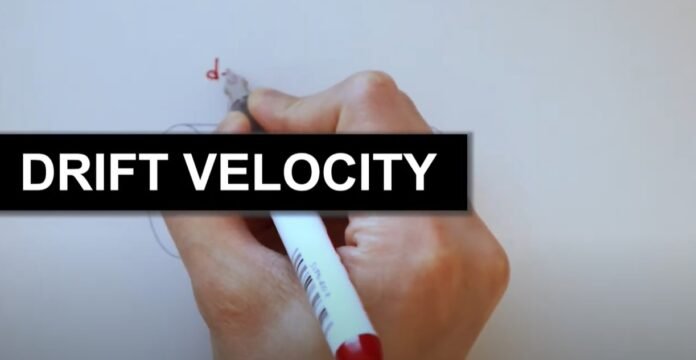Drift velocity refers to the average velocity of charged particles (such as electrons) as they move through a material under the influence of an electric field. When an electric field is applied to a material, it exerts a force on the charged particles, causing them to accelerate in the direction of the field.
The drift velocity depends on the strength of the electric field, the density of the charged particles, and the properties of the material they are moving through (such as its resistivity and temperature).
Drift Velocity
Drift velocity refers to the average velocity of charged particles, such as electrons or ions, in a material when subjected to an electric field.
When an electric field is applied to a conductor, the free electrons within the material are accelerated in the direction of the electric field. Due to the scattering of the electrons by the atoms and other imperfections within the material, the electrons do not move in a straight line, but rather move in a zigzag path with an average velocity in the direction of the electric field. This average velocity is called drift velocity.
The drift velocity can be calculated as-
Vd = μE
Where Vd is the drift velocity, μ is the electron mobility of the material, and E is the electric field strength.
Derivation of Drift Velocity
Consider a conductor in which electric field E is produced. Let a free electron experience a force (-eE) in this field then the acceleration of the free electron is given as –
a = F/m = -eE/m
The final velocity of free electron in time t1 is given as –
V1 = u1 + at1
For n free electrons the final velocity is v2, v3, v4, ………….vn.
The Average velocity of a free electron or drift velocity is given as
Vd = ( v1+v2+v3+………..+vn) / n
Vd = (u1 + at1 + u2 + at2 +………..+un + atn) /n
Vd = ( u1+u2+u3+……..un) + a(t1+t2+t3+…….+tn ) /n
But ( u1+u2+u3+……..un) /n = Average initial velocity of free electron = 0
And (t1+t2+t3+…….+tn ) /n = Average time taken between two collision =
= Relaxation time
So , Vd = a
Vd = (-eE/m) /
This is the derivation of Drift velocity.
Relation Between Drift Velocity And Electric Current
The relation between drift velocity and electric current is given as –
I = neAVd
Vd = I / (nAe)
where I is the electric current, n is the number of charge carriers per unit volume (e.g., electrons) in the conductor, A is the cross-sectional area of the conductor, e is the charge of the carrier, and Vdis the drift velocity.
This equation shows that the electric current is directly proportional to the number of charge carriers, the cross-sectional area of the conductor, and the drift velocity of the charge carriers.
Relation Between Drift Velocity and Current Density
Drift velocity is the average velocity of charge carriers (usually electrons) in a material in the presence of an electric field. It is related to the current density, which is the amount of current flowing through a unit area of a material, by the following equation:
J = I/A = neVd
where J is the current density, n is the number of charge carriers per unit volume, e is the charge of an electron, Vd is the drift velocity.
Recommended Articles:
Derivation Of Biot Savart Law: Application, Importance, FAQ
Centripetal Acceleration: Introduction, Force, Derivation, And Applications
The Compton Effect: Introduction, Experiment, Derivation, Shift, And Confirmation
Derivation Of Continuity Equation: Introduction, Assumption, Applications, And Example
Derivation of Doppler Effect
Drift velocity is the average velocity of charged particles, such as electrons, in a conductor when an electric field is applied. It is the net velocity of electrons in the direction of the electric field and is measured in meters per second. The formula for drift velocity is Vd = μE Where Vd is the drift velocity, μ is the mobility of the charged particles, and E is the electric field strength. The drift velocity of charged particles depends on the strength of the electric field, the mobility of the particles, and the density of the particles in the material. Ans. The derivation of the formula for drift velocity assumes that the charged particles in the conductor are moving randomly before the electric field is applied and that they experience collisions with other particles in the conductor that randomize their direction of motion. It also assumes that the electric field is uniform throughout the conductor and that the collisions between particles are elastic, meaning that no energy is lost during the collisions. The relation between drift velocity and electric current is given as- I = neAVd Where I is the electric current, n is the number of charge carriers per unit volume, A is the cross-sectional area of the conductor, and v_d is the drift velocity. This equation states that the electric current is proportional to the drift velocity and the number of charge carriers in the conductor. Derivation Of Drift Velocity FAQs
What is drift velocity?
What is the formula for drift velocity?
What factors affect drift velocity?
What are the assumptions made in the derivation of the formula for drift velocity?
What is the relationship between drift velocity and electric current?
